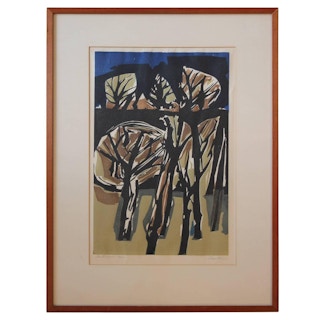Material
Woodcut Print
About
Woodcut print of fall trees done in heavy blacks with a deep blue background titled "Autumn" edition 10/100. Signed and titled by artist.
Artist Biography
Eugene Larkin was born into a farming family of seven children in rural Minnesota in 1921. The landscape and rhythms of agricultural life were a strong early influence, as was the artistic example of his painter mother, Martha. Larkin attended the University of Minnesota, graduating with an M.A. in 1947. As a student of the art historian Lawrence Schmeckebier, an authority on the art of the Mexican muralists, he was soon introduced to the expressionism and political engagement of German and Mexican artists of the 1920s and 30s. An early cycle of prints and drawings on the life of labor activist Joe Hill, with a catalog introduction by the novelist and activist Meridel LeSeur, reflected the artist's deep identification with the political struggles of the early labor union movement. The gestural expressionism that animated these early works remained characteristic throughout his career. Larkin's attention was soon captured by other themes: the drama of live chamber music and the elemental landscape of the northern Great Lakes. Larkin's wife, Audrey, was an amateur violinist, and their friendship with composer Markwood Holmes led to Larkin's work on the libretto of Holmes' opera Telemachus. In the early 1960s, Larkin was awarded a Ford Foundation grant to study at the newly formed Tamarind Institute, where he was introduced to the technique of stone lithography by the master printer Garo Antresian. During this period, however, Larkin began experimenting with a new technical direction that would come to dominate his creative output for several decades. Tree and plant forms had always been a favorite theme, and the artist realized that he could make a printed “rubbing” of an actual plant by covering a plant with paper, placing an uncarved inked woodblock on top and passing them together through his printing press. The process yielded tonally complex printed material that could be cut and reassembled into abstract collages; and the woodblocks, embossed by the plant forms during the process, could be reprinted to produce additional raw material. The accidental spatial and compositional arrangements of these cut up and collaged materials transmuted simple vegetative forms into arrangements richly imbued with figurative associations. Further, the same process could be carried out on lithographic transfer paper, yielding a print rather than a collage as a finished result. Larkin was now appointed to a professorship at the University of Minnesota, where he taught art history and design. He had collaborated previously with several skilled printers, among them Kenji Akagawa and Jerry Martin, but around this time that role began to be filled by his son Alan Larkin, himself a printmaker and art professor at Indiana University in South Bend. Alan and Eugene worked together from then on to create editions of Eugene's printed work. Production of collages continued apace, many of them large scale works with printed papers adhered to canvas. Using an experimental paper manufactured by 3M, Larkin had begun, in Alan's words, to “draw with scissors”, exploring accidental relationships of printed rubbings, woodcut fragments and solid fields of color, flowing collaged abstractions with architectural, totemic and even erotic overtones. Larkin's work as an instructor of two and three-dimensional design came to influence his vision in a number of new ways, as he introduced his students to problems in design and composition.
Dimensions
H 27 in. x W 20 in. x D 1 in.

